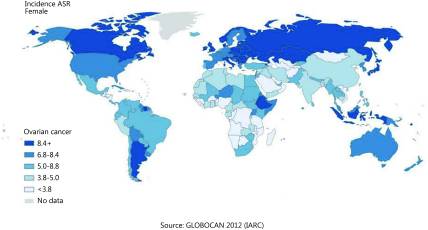Sexcord/ stromal ovarian tumors epidemiology and demographics
|
Sexcord/ stromal ovarian tumors Microchapters |
|
Differentiating Sexcord/ Stromal Ovarian Tumors from other Diseases |
|---|
|
Diagnosis |
|
Treatment |
|
Case Studies |
|
Sexcord/ stromal ovarian tumors epidemiology and demographics On the Web |
|
American Roentgen Ray Society Images of Sexcord/ stromal ovarian tumors epidemiology and demographics |
|
FDA on Sexcord/ stromal ovarian tumors epidemiology and demographics |
|
CDC on Sexcord/ stromal ovarian tumors epidemiology and demographics |
|
Sexcord/ stromal ovarian tumors epidemiology and demographics in the news |
|
Blogs on Sexcord/ stromal ovarian tumors epidemiology and demographics |
|
Risk calculators and risk factors for Sexcord/ stromal ovarian tumors epidemiology and demographics |
Editor-In-Chief: C. Michael Gibson, M.S., M.D. [1]; Associate Editor(s)-in-Chief:
Overview
Epidemiology and Demographics
Incidence
Ovarian sex cord-stromal tumors are very uncommon neoplasms that represent only 7% of all ovarian tumors[1][2]
- The yearly adjusted incidence rate is approximately 2 per 1,000,000 women for SCSTs

Prevalence
- The incidence/prevalence of [disease name] is approximately [number range] per 100,000 individuals worldwide.
- In [year], the incidence/prevalence of [disease name] was estimated to be [number range] cases per 100,000 individuals worldwide.
- The prevalence of [disease/malignancy] is estimated to be [number] cases annually.
Case-fatality rate/Mortality rate
- In [year], the incidence of [disease name] is approximately [number range] per 100,000 individuals with a case-fatality rate/mortality rate of [number range]%.
- The case-fatality rate/mortality rate of [disease name] is approximately [number range].
Age
The age at presentation varies depending on the subtypes of sexcord-stromal ovarian tumors:[3]
Fibromas:
- Although they can present at any age, the mean age of occurrence is in the late forties
Thecomas:
- They are more likely to occur in postmenopausal women
Sclerosing stromal tumor(SSTs):
- SSTs are more likely to occur in young women
- Approximately 80% of the reported cases are under 30 years of age
- A few cases have been reported in premenarchal girls, although SSTs most commonly occur after menarche
Steroid cell tumors:
- The average age of presentation is 43 years
Adult and juvenile granulosa cell tumors:
- The incidence of adult granulosa cell tumors peaks in early postmenopausal women
- The juvenile form occurs predominantly in children and young women (<30 years)
Race
- Racial predilection do exist for sexcord-stromal ovarian tumors[2]
- Racial differences in incidence and mortality within the United States are similar to the observed international variation
- Sexcord-stromal ovarian tumors(SCSTs) have more predilection in women of Caucasian background
- Rates are highest among Whites, intermediate for Hispanics, and lowest among Blacks, and Asian people
Region
- The majority of [disease name] cases are reported in [geographical region].
- [Disease name] is a common/rare disease that tends to affect [patient population 1] and [patient population 2].
Developed Countries
Developing Countries
References
- ↑ Reid BM, Permuth JB, Sellers TA (February 2017). "Epidemiology of ovarian cancer: a review". Cancer Biol Med. 14 (1): 9–32. doi:10.20892/j.issn.2095-3941.2016.0084. PMC 5365187. PMID 28443200.
- ↑ 2.0 2.1 Boussios S, Zarkavelis G, Seraj E, Zerdes I, Tatsi K, Pentheroudakis G (October 2016). "Non-epithelial Ovarian Cancer: Elucidating Uncommon Gynaecological Malignancies". Anticancer Res. 36 (10): 5031–5042. doi:10.21873/anticanres.11072. PMID 27798862.
- ↑ Horta M, Cunha TM (2015). "Sex cord-stromal tumors of the ovary: a comprehensive review and update for radiologists". Diagn Interv Radiol. 21 (4): 277–86. doi:10.5152/dir.2015.34414. PMC 4498422. PMID 26054417.